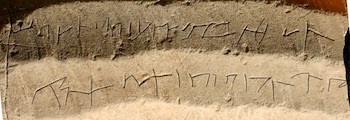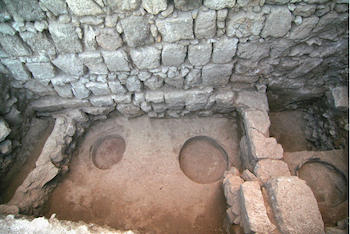Shimon Gibson, Co-Director of Dig
James D. Tabor, Co-Director of Dig
Rafi Lewis, Field Director
Zvika Tsuk, Archaeologist
Evyatar Cohen, Regional Director
January 2009
A unique ten-line inscription on the side of a stone cup commonly used for ritual purity during the first century CE was recently uncovered in archaeological excavations conducted this summer on Mount Zion in Jerusalem. Inscriptions of this kind are extremely rare and only a handful has been found in scientific excavations made within the city.
The archaeological excavations are being carried out within the national park “Gan Sovev Homot Yerushalayim” close to the Zion Gate of the Old City. The work is directed by Professors Shimon Gibson and James Tabor of the University of North Carolina at Charlotte, with the co-ordination of Evyatar Cohen and Dr Tsvika Tsuk of the Israel Parks Authority. These excavations follow earlier excavations at the site made in the 1970s by Magen Broshi, when a monumental Arabic inscription from the thirteenth century was found (it is to be exhibited in the new archaeological wing to be opened next year at the Israel Museum).
The new inscription from the first century CE is presently being deciphered by a team of epigraphic experts in an effort to determine the meaning of the text, which is clear but cryptic.

View of two lines of the inscription.
The dig also produced a sequence of building remains dating from the history of Jerusalem, from the First and Second Temple periods through to Byzantine and Early Islamic periods. From the Second Temple period archaeologists uncovered a house complex with a mikveh (purification pool) with a remarkably well preserved vaulted ceiling.

Interior of mikveh from the Second Temple period.
Inside this house were three bread ovens with a level of burning dating from the year 70 CE when Titus and the Roman troops stormed the city.

Top view of bread ovens from the Second Temple period.
Archaeologists believe that this area of the Upper City of Jerusalem served as the priestly quarter of Jerusalem during Second Temple times. In support of this were interesting finds including an ornate window screen made of stone. Ten murex shells were also found and these were used for producing the argaman dye which was used for the coloring the priestly vestments at that time.
In addition, a large arched building with a mosaic floor (preserved to a height of 3 metres) from the Byzantine period was also uncovered; perhaps it is part of a building complex or street associated with the nearby Church of St Mary (the Nea).
